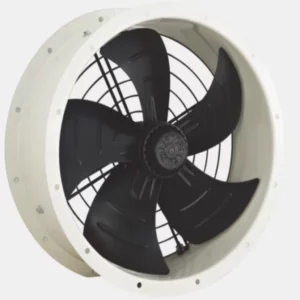What is AC axial fan and Where does AC axial fan apply?
An AC axial fan is a type of fan that uses an alternating current (AC) power source to generate airflow. It is characterized by its design, which consists of a rotating impeller or blade that draws air in parallel to the fan’s axis and expels it in the same direction.
Here are some key features and characteristics of AC axial fans:
- Design: AC axial fans have a cylindrical or disc-shaped housing with an impeller mounted inside. The impeller typically consists of multiple blades or vanes arranged in a radial pattern around a central hub. The impeller is connected to an electric motor, which drives its rotation.
- Airflow Direction: AC axial fans produce airflow in a direction parallel to the fan’s axis. The impeller draws air in from one side of the fan and expels it on the other side, creating a unidirectional airflow.
- Cooling Applications: AC axial fans are commonly used for cooling purposes in various applications. They are often found in electronic devices, appliances, ventilation systems, and cooling equipment where the primary objective is to dissipate heat and maintain optimal operating temperatures. For example, AC axial fans are used in computer cooling systems, refrigeration units, air conditioners, and heat exchangers.
- Efficiency and Performance: AC axial fans are known for their relatively high efficiency and airflow capacity. They can generate a significant volume of airflow while consuming relatively low power. The efficiency and performance of an AC axial fan depend on factors such as the design of the impeller, motor efficiency, and the overall fan construction.
- Size and Mounting Options: AC axial fans are available in various sizes, ranging from small fans used in electronics to large fans employed in industrial applications. They can be mounted directly onto a surface, such as a panel or heat sink, using screws or other mounting mechanisms. Some AC axial fans also come with mounting brackets or frames for easy installation.
- Noise Level: The noise level produced by an AC axial fan can vary depending on factors such as fan size, speed, and design. However, compared to other types of fans, axial fans generally produce a relatively lower noise level. This makes them suitable for applications where noise reduction is desired.
- AC Power Source: AC axial fans are designed to operate on alternating current (AC) power supply, typically at standard voltages such as 120V or 240V. They are directly powered by the electrical grid or through an AC power source, making them widely compatible with standard electrical systems.
AC axial fans are widely used for cooling and ventilation purposes in various industries and applications. They offer efficient airflow, reliable performance, and ease of installation, making them a popular choice for cooling electronic components, equipment, and machinery.
Where does AC axial fan apply ?
AC axial fans find application in a wide range of industries and settings where cooling and ventilation are required.
Here are some common areas where AC axial fans are applied:
- Electronics and Computers: AC axial fans are commonly used in electronic devices, such as computers, servers, routers, and gaming consoles. They help dissipate heat generated by electronic components, preventing overheating and ensuring reliable operation.
- HVAC Systems: AC axial fans are an integral part of heating, ventilation, and air conditioning (HVAC) systems. They assist in circulating air, cooling heat exchangers, and maintaining comfortable indoor temperatures in residential, commercial, and industrial buildings.
- Appliances: AC axial fans are used in various household appliances, including refrigerators, air purifiers, dehumidifiers, and range hoods. They aid in removing heat, improving air quality, and facilitating proper functioning of these appliances.
- Automotive Cooling: AC axial fans are employed in automotive applications, particularly for cooling radiators and engine compartments. They help dissipate heat generated by the engine and maintain optimal operating temperatures.
- Industrial Cooling: AC axial fans are utilized in industrial settings to cool machinery, equipment, and industrial processes. They assist in dissipating heat from manufacturing processes, cooling generators, compressors, and other industrial equipment.
- Ventilation Systems: AC axial fans play a crucial role in ventilation systems, including commercial and residential ventilation, exhaust systems, and air circulation in confined spaces. They help remove stale air, odors, and contaminants, promoting fresh and healthy air circulation.
- Agricultural Applications: AC axial fans are used in agricultural settings, such as livestock buildings and greenhouses, to provide proper air circulation and cooling for animals and plants. They aid in maintaining suitable environmental conditions for agricultural production.
- Cooling Towers: AC axial fans are integral components of cooling towers used in industrial processes, power plants, and HVAC systems. They facilitate the removal of heat from the cooling medium, enhancing the efficiency of the cooling process.
- Server Rooms and Data Centers: AC axial fans are extensively employed in server rooms and data centers to ensure the cooling of server racks and equipment. They help maintain stable temperatures and prevent heat-related issues that can affect the performance and reliability of servers.
These are just a few examples of the diverse applications of AC axial fans. Their ability to provide efficient airflow and cooling makes them essential components in numerous industries and settings where heat dissipation and ventilation are critical.
